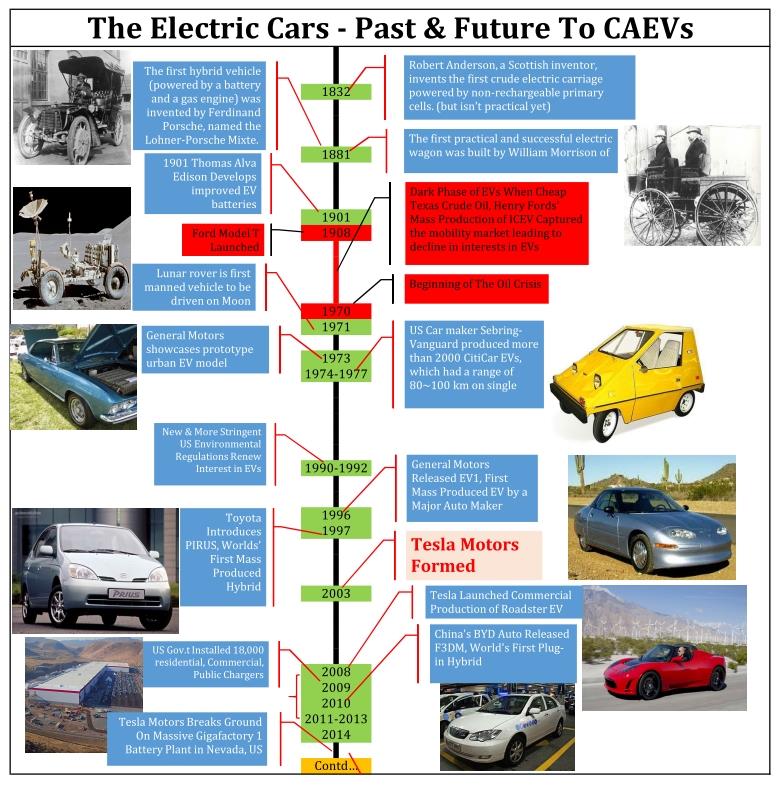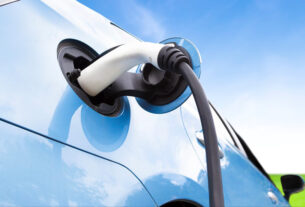
Article by By Prabhat Khare, Director, KK Consultants
An electric vehicle (EV), is a vehicle that uses one or more electric motors or traction motors for propulsion as its main drive which may be powered through a collector system by electricity from off-vehicle sources, or may be self-contained with a battery, solar panels, fuel cells or an electric generator to convert fuel to electricity. EVs include, but are not limited to, road and rail vehicles, surface and underwater vessels, electric aircraft and electric spacecraft.
However, in common terminology EV is used for Automobiles which came into existence in the mid-19th century, when electricity was among the preferred methods for motor vehicle propulsion, providing a level of comfort and ease of operation that could not be achieved by the gasoline cars of the time. Rise of internal combustion engines due to rapid technological development in IC engine technology, manufacturing processed as well as its overall eco-system dominated the road transportation for almost 100 years now and electric power was pushed to other bigger kindly either heavy or lighter mobility applications, such as trains and smaller vehicles. Due to changes business scenario, technological developments in electrical traction, battery technology and power controls & charging systems and an increased focus on renewable energy and the potential reduction of transportation’s impact on climate change and other environmental issues, post 2000, EVs have seen a resurgence. Project Drawdown describes electric vehicles as one of the 100 best contemporary solutions for addressing climate change.
Development & Growth of EVs
EVs has very long history, starting from 1834, 50 years earlier than first petrol powered Internal Combustion Engine Vehicle (ICEV), which was only built in 1879 by Carl Benz. In the early 1900s, mobile market was rules by EVs as they were better than the ICEVs. EVs had a number of advantages over their early 1900s competitors. They did not have the vibration, smell, and noise associated with ICEV vehicles. They also did not require gear changes. The cars were also preferred because they did not require a manual effort to start, as did gasoline cars which featured a hand crank to start the engine.
However, it was only after 1880 when Edison lit his first light bulb, the real interest in EVs started taking shape. However it had to wait for another 5 years till 1891, when A. L. Ryker built an electric tricycle and in the same year William Morrison built a six-passenger wagon. In 1895 more engineers began to devote their attention to EVs. Many innovations followed and the interest in EVs increased greatly in the late 1890s and early 1900s. In fact, William Morrison’s design with a one passenger capacity is often considered the first real and practical EV. The last decade of the 19th century was a blooming period in the early development of EVs. The ‘‘Electrobat’’ was converted from a delivery wagon, and ran on the streets of Philadelphia, PA, in 1894. It is also interesting to note that the first vehicle running over the 100-km/h barrier was an EV, namely, the ‘‘Jamais Contente’’ (Never Satisfied), which was driven by Camille Jenatzy, a Belgian. It was a bullet-shaped electric racing car, and it captured the record of 110 km/h on May 1, 1899. In fact, before the preeminence of ICEVs, EVs had held many speed and distance records. In addition, electric trains were used to transport coal, as their motors did not use up precious oxygen. Also many of metropolitan cities including that of India’s had electrical trams running as a public transport vehicles.
Fall of EVs
However, in short span of 30 years, the fall of EVs had already began because of various prevailing factors e.g. development of improved & long road system in US demanding a need for vehicles which could travel longer distances, have ease of refueling, system of which was made available when crude oil was discovered in Texas in 1901 the oil boom followed, resulting in continuous fall of oil prices & forcing people to create the whole network of fuel transportation, handling storage & distribution system. The infrastructure needed for EVs growth could not match this pace of development which pushed market for ICEVs. At the same time, came very few fundamental innovations like invention of the electric starter by Charles Kettering in 1912, eliminating the need for the hand crank or kick starting.
But finally plugs for EVs were pulled out Henry Ford who had clearly focused on creating an affordable ICEV for the masses and in the process developed many innovative ideas including most famous innovation of Mass Production on the Moving Assembly Line, a process that dramatically kept on reducing the process time 514 minutes to 2.3 minutes and later to 1.19 minutes. This gigantic reduction in takt time led to similar reduction in cost of Ford’s ICEVs, which could be sold at affordable price range of $500 –$1000 price. The demand of his Model T ICEV was so high that in the year 1920 the Ford vehicles touched 2 million volumes sales. By contrast, the price of the EVs continued to rise and by the end of 1912, an EV was being for $1750. Milburns a leading EVs manufacturer during 1915 to 1923 had sold to GM, post which no new serious efforts were made at Detroit on EVs. In 1929, W. C. Anderson sold the company & in the same year the last Detroit EV under Anderson was shipped. ICEVs kept increasing their grip on automotive market & post WWII, “Lean Manufacturing” of Eiji Toyoda & Taiichi Ohno of Toyota Motor Company ensured that it tightened more. The ICEVs kept dominating the automobile market for next few decades adding on millions of ICAVs on roads every year. Slowly by 1936 the EVs disappeared from market. There were many other factors which contribute in this fall of EVs as mention above which were later immortalized in a documentary “Who Killed the Electric Car?” (Directed by Chris Paine, Produced By Electric Entertainment, Distributed By Sony Pictures Classics In 2006).
However because of their inherent much better qualities and features, the EVs never died completely and most of the global companies kept on developing alternatives of EV technologies which led to the development HEVs, PHEVs which tried to combine best of ICEVs and then there was altogether FCEVs which used liquid hydrogen as its fuel and generated pure water in the process of combustion. These development are summarized below:
Diversified Electrical Vehicle Technologies
It was only a matter of the right time when EVs could bounce back.
The Revival
Revival of EVs could be contributed to three unrelated incidents but contributed greatly in the comeback of EVs. First one was the oil crisis of 1970s, second was development of MOSFET (metal–oxide–semiconductor field-effect transistor) in 1959 which paved the path to the development of IGBT rectifier & inverters combination & third one came 1980s when John Goodenough, Rachid Yazami and Akira Yoshino developed lithium-ion battery.
Utilizing this innovations, Tesla invested heavily in EV technology between 2003~205 and in 2008 developed the cutting-edge battery technology and electric powertrain need for EVs. From there, Tesla designed the world’s first ever premium all-electric sedan from the ground up – Model S – which became the best car in its class, combining safety, performance, and efficiency.
Future of EVs & CAEVs
There are many inherent advantages of EVs however the most critical ones are – 1) EVs have very low adverse impact on environment throughout their life cycle, 2) EVs have a much smaller carbon footprint & 3) EVs have much lower ownership cost over their whole life cycle. With success of Tesla cars as well as of many others, coupled with rise of internet/IoTs in last few decade, Connected and Autonomous Electric Vehicles (CAEVs) were the natural successors of EVs which can provide a well-controlled & coordinated transportation system which is self-governed, self-driven, self-controlled, self-corrected and which requires least human interference as far as mobility issues are concerned.
Such vehicles, which while on move, could access to a wide range of data as well integrate them with each other, would become more proactive, well-informed and coordinated in the future. A highly complex & interconnected future, in which these CAEVs would be able to “talk” with each other, their surroundings like smart roads, smart signals, smart parking lots, local terrain and geographical information, weather condition including many other such informations as well as with live traffic data. Coupled with their extremely high level of computation capacities, these CAEVs will be able autonomously work out the best, most comfortable & safest possible routes for the humans travelling in them without their intervention.
Thus these CAEVs in future would create more free time for people traveling in them, enhance traffic safety leading to accident prevention; improving accessibility, comfort and in-vehicle riding experience; potentially making it easier for policymakers to prioritize car-sharing and ride-sharing business models; and reducing road traffic congestion, environmental degradation, air pollution, noise nuisance and social exclusion for those currently unable to drive to name a few.
The new automotive industry in which EVs are the clear leader, is still evolving where old guards are falling while new ones are taking over, by reinventing the proven methodologies, like mass production/ lean manufacturing, which were master over almost a century during the rise of ICEVs.
These EVs manufactures are actively working on the development of CAEVs and conducting trials with various degrees of success is a mix of traditional car manufacturers, ride-hailing and intelligence companies. IT & electronics based companies like Google, Apple, Uber, Ola & Sony which are not presently in a mobility business, are investing heavily in EVs which will radically change the dynamics of the automotive industry, where ICT will be a difference-making competitive advantage.
With this dramatic shift in mobility arena, 150 years old conventional automotive industry will be forced to adopt new business models for sales as well after sales services. While sale will prioritize shared use over private ownership the after sales service network will also have to change drastically from current service setup which is more or less a mechanical process and many times can be found in nooks and corner of every city to a highly complex service setup. The new setup has to evolve where block replacement of units would be more prominent as compared to current trend of repairing & sub-component replacement. In the context of smart cities which will promote sustainable growth and provide tremendous growth opportunities for these CAEV who will slowly become the epicenter of all transportation, providing smart mobility solutions by forming an interconnected vehicular network assessing & analyzing varied diversified live information. With this kind of complex networked & integrated future society in which CAEVs will always be dynamic, interacting & interfacing with human beings who will be using them for their all mobility solutions, it is expected that there will be many expected & many more unforeseen potential benefits & challenges to users & society as well as to CAEVs themselves. Some of them are listed below broadly categorized in three categories:
Epilogue
CAEVs are a certainty and it is only a matter of time when they become a part of human lives. They are going to lead a much bigger change in transforming the whole mobility system as we today, related energy network infrastructure, road, signaling, parking infrastructures, Rules related to traffic violation and insurance claims, vehicular ownership and travel habits of people.
Control and track of these CAEVs as well as changing human’s behaviors while interacting with such autonomous mobile machines which will generate enormous amount of movement related information will require exponential large computational and AI capacities leading to next major boom in this field of Information Technology. CAEVs are projected to be the next gold standard of mobility, transforming automotive industry, city development, the whole gamut of infrastructure what we see today and probably the way current social interaction takes place. The rise of current trend in the EVs is certainly a step in bringing this dramatic change which has paced up in last decade since conventional ICEVs could not have provided this intelligent interface of an automobile despite having a highly sophisticated system with all their mechanical complexities. This would be an interesting transformation phase for both automotive industry as well as the whole society we live in.
However, it is very essential to note & remember that when Henry Ford developed the first ICEVs, they were not reliable, there were no gas stations, there was no precedence of many systems (like traffic singles, traffic regulations, expressways, highways, disposal eco-systems of these vehicles at end of their life) which are taken for granted currently, but he was still devoted to his creation (ICEV) by improving the quality & performance, reducing cost, and negotiating with oil companies to build the gas station infrastructure and to establish the maintenance service network. The philosophy of making & continually improving a product, backing up system to create good infrastructure, and focusing on a good business model of providing economical & affordable product for mass convenience of varied usage to reduce human burden and effort still remains valid. Most importantly, his philosophy of having an open mind and having courage to develop & continually improve a new technology with a focused business philosophy will continues to inspire EV/CAEV manufacturers across the globe.
About the author: The author is a BE (Electrical) Gold Medalist from IIT Roorkee. He can be reached on +91 99104 90088 or kkconsultantsnoida@gmail.com, kkconsultantsiitr82@gmail.com










